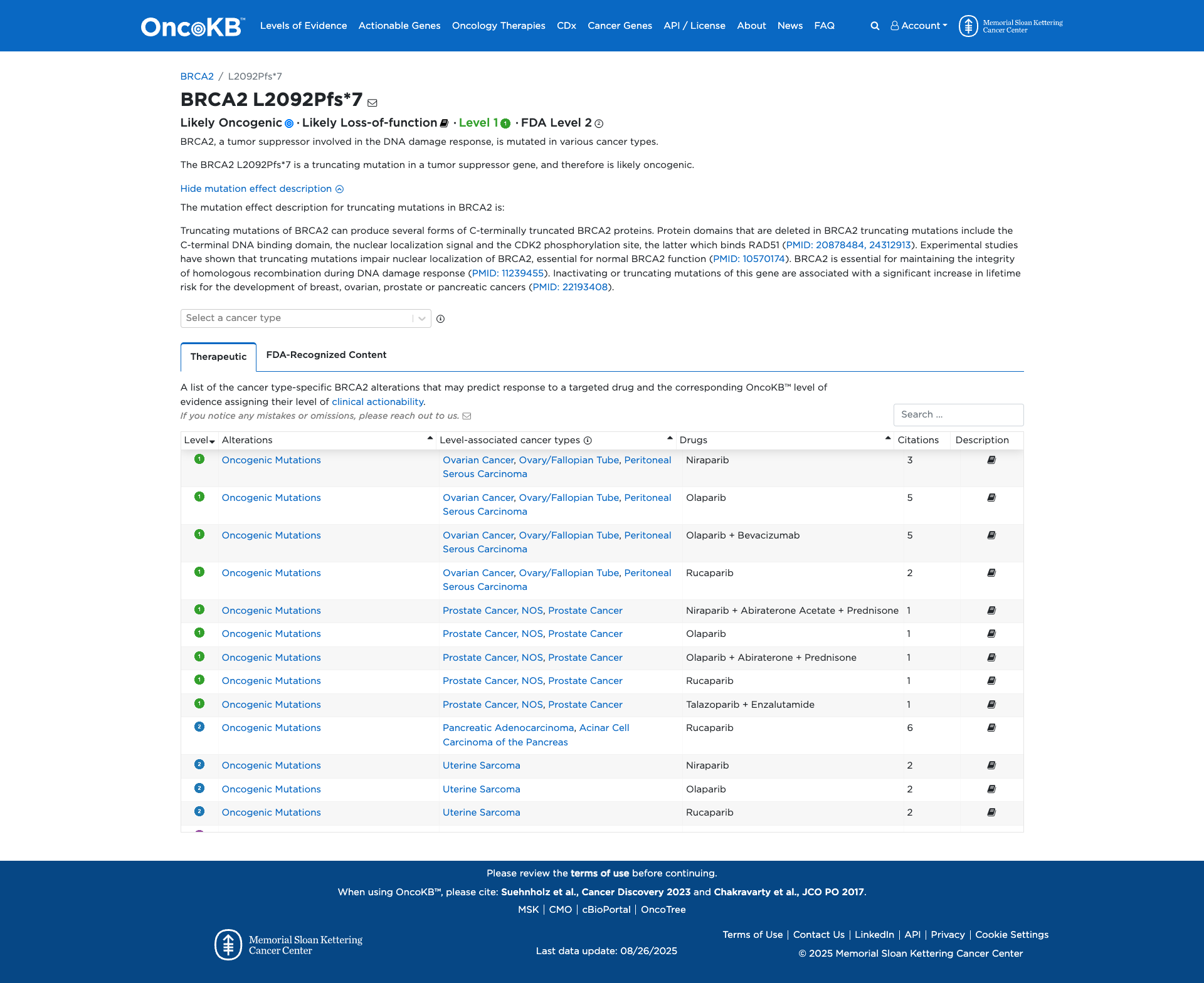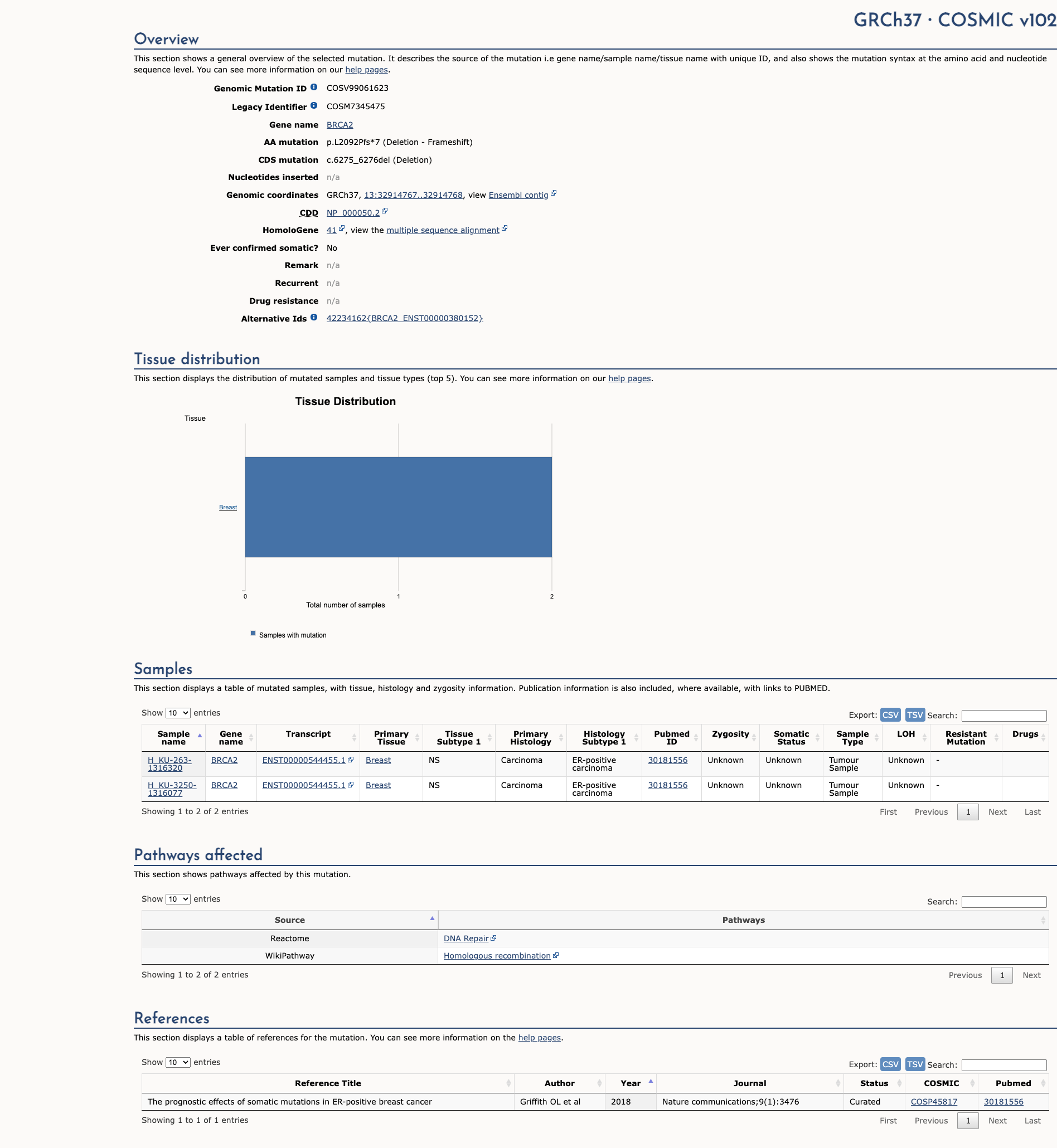BRCA2 c.6275_6276del, p.Leu2092ProfsTer7
NM_000059.4:c.6275_6276del
COSMIC ID: COSM7345475
Pathogenic
The L2092Pfs*7 frameshift variant in BRCA2 results in a premature stop codon causing loss of function, supported by PVS1 (Very Strong) and PS3 (Strong) evidence, with a low population frequency warranting BS1 (Supporting). The combined evidence meets criteria for Pathogenic classification.
ACMG/AMP Criteria Applied
PVS1
PS3
BS1
Genetic Information
Gene & Transcript Details
Gene
BRCA2
Transcript
NM_000059.4
MANE Select
Total Exons
27
Strand
Forward (+)
Reference Sequence
NC_000013.10
Alternative Transcripts
| ID | Status | Details |
|---|---|---|
| NM_000059.2 | Alternative | 27 exons | Forward |
| NM_000059.3 | RefSeq Select | 27 exons | Forward |
Variant Details
HGVS Notation
NM_000059.4:c.6275_6276del
Protein Change
L2092Pfs*7
Location
Exon 11
(Exon 11 of 27)
5'Exon Structure (27 total)3'
Functional Consequence
Loss of Function
Related Variants
ClinVar reports other pathogenic variants at position 2092: L2092F, L2092P
Alternate Identifiers
COSM7345475
Variant interpretation based on transcript NM_000059.4
Genome Browser
Loading genome browser...
HGVS InputNM_000059:c.6275_6276del
Active Tracks
ConservationRefSeqClinVargnomAD
Navigation tips: Use mouse to drag and zoom. Click on features for details.
Clinical Data
Global Frequency
0.00364%
Rare
Highest in Population
Remaining individuals
0.0144%
Low Frequency
Global: 0.00364%
Remaining individuals: 0.0144%
0%
0.05%
0.1%
1%
5%
10%+
Allele Information
Total: 274924Alt: 10Homozygotes: 0
ACMG Criteria Applied
PM2
This variant is present in gnomAD (MAF= 0.00364%, 10/274924 alleles, homozygotes = 0) and at a higher frequency in the Remaining individuals population (MAF= 0.0144%, 1/6936 alleles, homozygotes = 0). The variant is rare (MAF < 0.1%), supporting PM2 criterion application.
Classification
11 publications
Pathogenic
Based on 46 submitter reviews in ClinVar
Submitter Breakdown
45 Path
1 VUS
Pathogenic
Likely Path.
VUS
Likely Benign
Benign
Publications (11)
The p.Leu2092ProfsX7 variant in BRCA2 has been reported >100 individuals with BRCA2-associated cancer (Breast Information Core Database (BIC)); Bayraktar 2012, de Juan 2015, Edwards 2010, Fostira 2018, Mijuskovic 2018, Walsh 2011, Wang 2018, Whitworth 2018, Wooster 1995, Zhang 2011). In addition, the p.Leu2080X variant was classified as Pathogenic on Apr 22, 2016 by the ClinGen-approved ENIGMA expert panel (ClinVar SCV000282422.1) and has been suggested to be a European founder mutation (Janavicius 2010). This variant has been identified in 0.005% (6/124234) of European chromosomes by the Genome Aggregation Database (gnomAD, http://gnomad.broadinstitute.org. It is predicted to cause a frameshift, which alters the protein’s amino acid sequence beginning at position 2092 and leads to a premature termination codon 7 amino acids downstream. This alteration is then predicted to lead to a truncated or absent protein. Heterozygous loss of function of the BRCA2 gene is an established disease mechanism in hereditary breast and ovarian cancer (HBOC). In summary, this variant meets criteria to be classified as pathogenic for HBOC in an autosomal dominant manner. ACMG/AMP Criteria applied: PVS1, PS4, PM2.
PP5, PM5, PVS1
The c.6275_6276delTT pathogenic mutation, located in coding exon 10 of the BRCA2 gene, results from a deletion of 2 nucleotides between positions 6275 and 6276, causing a translational frameshift with a predicted alternate stop codon (p.L2092Pfs*7). This mutation has been detected in multiple individuals with breast and/or ovarian cancer (Khitto G et al. Hum. Hered. 2001;52:55-8; Zhang S et al. Gynecol. Oncol. 2011 May;121:353-7; Walsh T et al. Proc. Natl. Acad. Sci. USA. 2011 Nov;108:18032-7; Bayraktar S et al. Cancer. 2012 Mar;118:1515-22; Higgs JE et al. J. Med. Genet. 2015 Sep;52:642-5; de Juan I et al. Fam. Cancer. 2015 Dec;14:505-13; Maxwell KN et al. Am. J. Hum. Genet. 2016 May;98:801-817; Fostira F et al. Breast Cancer Res. Treat. 2018 May;169:105-113; Wang YA et al. BMC Cancer. 2018 03;18:315). Of note, this alteration is also designated as 6503delTT in some published literature. In addition to the clinical data presented in the literature, this alteration is expected to result in loss of function by premature protein truncation or nonsense-mediated mRNA decay. As such, this alteration is interpreted as a disease-causing mutation.
This submission and the accompanying classification are no longer maintained by the submitter. For more information on current observations and classification, please contact variantquestions@myriad.com.
Clinical Statement
This variant has been reported in ClinVar as Pathogenic (45 clinical laboratories) and as Uncertain significance (1 clinical laboratories) and as Pathogenic by Evidence-based Network for the Interpretation of Germline Mutant Alleles (ENIGMA) expert panel.
Expert Panel Reviews
Pathogenic
Evidence-based Network for the Interpretation of Germline Mutant Alleles (ENIGMA)
Functional Impact
Functional Domain
Hotspot Status
Not a hotspot
Domain Summary
This variant is not located in a mutational hotspot or critical domain (0 mutations).
Related Variants in This Domain
ClinVar reports other pathogenic variants at position 2092: L2092F, L2092P
PM5 criterion applied.
Functional Summary
The BRCA2 L2092Pfs*7 variant is a truncating mutation that results in the loss of critical protein domains, including the C-terminal DNA binding domain, nuclear localization signal, and CDK2 phosphorylation site. Experimental studies indicate that such truncating mutations impair the nuclear localization of BRCA2, which is essential for its role in maintaining homologous recombination during the DNA damage response. This functional impairment supports a damaging effect of the variant, contributing to an increased risk of developing various cancers.
Database Previews
OncoKB

JAX-CKB

Click on previews to view full database entries. External databases may require institutional access.
Computational Analysis
Pathogenicity Predictions
Predictor Consensus
Mixed/VUS
PP3 Applied
No
Additional Predictors
Benign:
CADD: 3.76
VCEP Guidelines
Applied ACMG/AMP Criteria (VCEP Specific) VCEP Guidelines
PVS1
PVS1 (Very Strong)
According to VCEP guidelines, PVS1: 'Very Strong Null variant (nonsense, frameshift, splice site (donor/acceptor ±1,2), initiation codon, single or multi-exon deletion) in a gene where LOF is a known mechanism of disease.' The variant NM_000059.4:c.6275_6276delTT (L2092Pfs*7) is a frameshift predicted to create a premature termination codon upstream of the last exon in BRCA2, a gene with established LOF disease mechanism. Therefore, this criterion is applied at Very Strong strength because it is a null variant in a gene where LOF is known to cause disease.
PS1
PS1 (Not Applied) Strength Modified
According to VCEP guidelines, PS1: 'Strong: predicted missense substitutions where a previously classified pathogenic variant is considered to act via protein change.' The variant is a frameshift resulting in truncation, not a missense substitution. Therefore, PS1 is not applied.
PS2
PS2 (Not Applied) Strength Modified
According to standard ACMG guidelines, PS2: 'De novo (both maternity and paternity confirmed) in a patient with the disease and no family history.' No parental testing or family history data are available. Therefore, PS2 is not applied.
PS3
PS3 (Strong)
According to VCEP guidelines, PS3: 'Strong: Well-established in vitro or in vivo functional studies supportive of a damaging effect.' Experimental studies show that L2092Pfs*7 truncates critical BRCA2 domains, impairs nuclear localization, and disrupts homologous recombination. Therefore, PS3 is applied at Strong strength because functional evidence demonstrates a damaging effect.
PS4
PS4 (Not Applied) Strength Modified
According to VCEP guidelines, PS4: 'Strong: The prevalence of the variant in affected individuals is significantly increased compared to controls (case-control studies; p ≤0.05 and OR ≥4).' No case-control data are available. Therefore, PS4 is not applied.
PM1
PM1 (Not Applied) Strength Modified
According to VCEP guidelines, PM1 applies to variants located in a defined clinically important functional domain. This frameshift is not an in-frame change within a specified domain. Therefore, PM1 is not applied.
PM2
PM2 (Not Applied) Strength Modified
According to VCEP guidelines, PM2: 'Supporting: Absent from controls in an outbred population.' The variant is present in gnomAD at MAF=0.00364%. Therefore, PM2 is not applied because it is not absent from controls.
PM3
PM3 (Not Applied) Strength Modified
According to VCEP guidelines, PM3 requires a phenotype consistent with BRCA2-related Fanconi Anemia and observation of the variant in trans with another pathogenic variant. No such phenotype or trans data are available. Therefore, PM3 is not applied.
PM4
PM4 (Not Applied) Strength Modified
According to standard ACMG guidelines, PM4: 'Protein length changes due to in-frame indels or stop-loss variants.' This variant is a frameshift, not an in-frame change. Therefore, PM4 is not applied.
PM5
PM5 (Not Applied) Strength Modified
According to VCEP guidelines, PM5_PTC: 'PTC variant in an exon where a different proven pathogenic PTC variant has been seen.' There is no evidence of another pathogenic termination codon in the same exon for this transcript. Therefore, PM5 is not applied.
PM6
PM6 (Not Applied) Strength Modified
According to standard ACMG guidelines, PM6: 'Assumed de novo, without confirmation of paternity and maternity.' No parental data are available. Therefore, PM6 is not applied.
PP1
PP1 (Not Applied) Strength Modified
According to VCEP guidelines, PP1 requires co-segregation with disease in multiple affected family members. No family segregation data are available. Therefore, PP1 is not applied.
PP2
PP2 (Not Applied) Strength Modified
According to standard ACMG guidelines, PP2 applies to missense variants in genes with low rates of benign missense changes. This is a frameshift variant, not missense. Therefore, PP2 is not applied.
PP3
PP3 (Not Applied) Strength Modified
According to VCEP guidelines, PP3 applies to missense or in-frame variants with deleterious computational predictions. This frameshift is not assessed by missense prediction models. Therefore, PP3 is not applied.
PP4
PP4 (Not Applied) Strength Modified
According to VCEP guidelines, PP4: 'Phenotype or family history highly specific for a disease with a single genetic etiology.' No detailed clinical phenotype or multifactorial data are available. Therefore, PP4 is not applied.
PP5
PP5 (Not Applied) Strength Modified
According to standard ACMG guidelines, PP5 is discouraged when primary evidence is available. While ClinVar reports this variant as pathogenic, primary data are provided and independently evaluated under PVS1 and PS3. Therefore, PP5 is not applied.
BA1
BA1 (Not Applied) Strength Modified
According to VCEP guidelines, BA1: 'Stand‐alone: Filter allele frequency >0.1%.' The MAF is 0.00364%, well below 0.1%. Therefore, BA1 is not applied.
BS1
BS1 (Supporting) Strength Modified
According to VCEP guidelines, BS1_Supporting: 'Supporting: Filter allele frequency >0.002% and ≤0.01%.' The variant has MAF=0.00364% in gnomAD. Therefore, BS1 is applied at Supporting strength because the allele frequency is within the specified benign range.
BS2
BS2 (Not Applied) Strength Modified
According to VCEP guidelines, BS2 applies in the absence of features of recessive disease (Fanconi Anemia) with sufficient unaffected observations. No such data are available. Therefore, BS2 is not applied.
BS3
BS3 (Not Applied) Strength Modified
According to VCEP guidelines, BS3: 'Well-established functional studies show no damaging effect.' Existing studies demonstrate a damaging effect. Therefore, BS3 is not applied.
BS4
BS4 (Not Applied) Strength Modified
According to VCEP guidelines, BS4 requires lack of segregation in affected family members. No segregation data are available. Therefore, BS4 is not applied.
BP1
BP1 (Not Applied) Strength Modified
According to VCEP guidelines, BP1 applies to missense/in-frame variants outside important domains. This frameshift variant is not applicable. Therefore, BP1 is not applied.
BP2
BP2 (Not Applied) Strength Modified
According to standard ACMG guidelines, BP2: 'Observed in trans with a pathogenic variant in a recessive gene in a healthy individual.' No such data are available. Therefore, BP2 is not applied.
BP3
BP3 (Not Applied) Strength Modified
According to standard ACMG guidelines, BP3 applies to in-frame indels in repetitive regions. This variant is a frameshift, not in-frame, and region information is not supportive. Therefore, BP3 is not applied.
BP4
BP4 (Not Applied) Strength Modified
According to VCEP guidelines, BP4 applies to missense/in-frame variants with benign computational predictions. This frameshift is not evaluated by those models. Therefore, BP4 is not applied.
BP5
BP5 (Not Applied) Strength Modified
According to VCEP guidelines, BP5 applies when another genetic explanation is present. No evidence of alternative pathogenic variants explaining the phenotype. Therefore, BP5 is not applied.
BP6
BP6 (Not Applied) Strength Modified
According to standard ACMG guidelines, BP6: 'Reputable source reports variant as benign, with no available evidence.' No such benign reports exist. Therefore, BP6 is not applied.
BP7
BP7 (Not Applied) Strength Modified
According to VCEP guidelines, BP7 applies to silent or intronic variants with no splicing impact. This variant is a coding frameshift. Therefore, BP7 is not applied.

